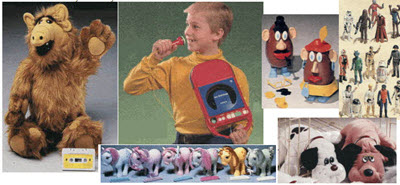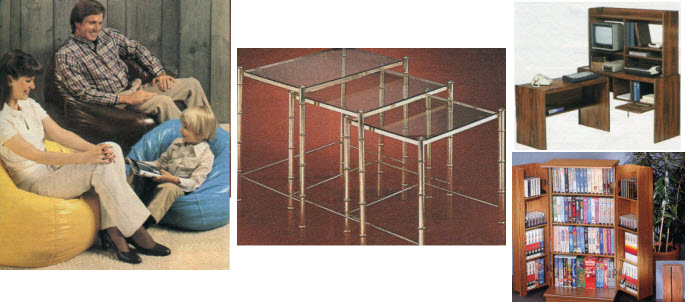History of Computers From The 1980's Including 80s Games and Consoles
Building on the success of the computers of the 1970s, the following decade created some technology that was unprecedented for its day. The computers produced and marketed during the 1980s only helped to increase the popularity of these convenient pieces of equipment throughout the decade and beyond. By the time the 1980s came to an end, it was unusual for a household to be without a personal computer. People were using them to play games and many other things, such as talk with others in the office network and other business-related applications. The computers during the 1980s also became more attractive and user-friendly as more and more people were buying them.
In 1982, the Commodore 64 took the nation by storm because of its price and the new capabilities that it offered. In addition to its unheard of $400 price tag (which was inexpensive for a personal computer at the time), it also had 64 Kb of RAM. This amount of RAM far surpassed any of the previous models and it was one of the major selling points that made this personal computer system one of the best-selling models of all time. Even 10 years after it was first introduced, the 22 million units of the Commodore 64 that were sold has been unmatched by any other single computer model.
The Commodore 64 recognized the success of previous models and brands and simply tried to improve on their technology. Within its own company, Commodore had produced the VIC-20, which was basically an early model of the Commodore 64. While the VIC-20 was a popular model, it still had flaws that the Commodore 64 did not have. The Commodore 64 was marketed toward the mass population and this model was the first portable model with a color display. As with previous models and brands, however, it still used cassette tapes as mediums for data storage with an optional floppy disk drive.
Following on the heels of the Commodore 64, the Commodore Amiga came out in 1985. This was a more expensive model ($1200) that many say was ahead of its time. Many of its capabilities were misunderstood by the general public because they did not even know computers were capable of some of the things the Amiga did. Games played on the Commodore Amiga had and awesome display of graphics and sound that nobody had seen before this model was introduced. Some units even came with 264 kilobytes of RAM, which was quadruple what the Commodore 64 was capable of. When the other computers of the day could only display 16 colors on the screen, the Commodore Amiga was capable of displaying over 4000 colors in high-resolution. This was also a popular model because it could be used for desktop video production and creating special effects for videos at home. The Commodore Amiga was also the first personal computer that was compatible with other operating systems in addition to the one it was supplied with.In 1984, the Apple MacIntosh made its appearance in the personal computer market. For $2500, computer users could own an Apple MacIntosh that had several added features than the computers from the previous decade. Introduced in a commercial during the 1984 Super Bowl, the Apple MacIntosh quickly became popular with its 128 Kb of Ram and its already installed 3.5” floppy disk drive. Users were delighted to use unique MacIntosh programs, including MacWrite (for word processing), Aldus PageMaker (for desktop publishing) and the MacPaint program (ideal for editing images). The MacPaint program also showed users the importance of using a mouse with a personal computer. In addition to these capabilities, the Apple Laser Printer quickly became the preferred printer of choice for computer owners of all brands.
The 1980s provided an ideal bridge between the beginning of the personal computer revolution in the 1970s and the flourishing of computers during the 1990s. Computer companies during the 80s took risks to help create more convenient models with increasing capabilities that everybody could take advantage of. As a result of their technology design and hard work, the following decade was able to become what many refer to as “The Age of Personal Computers.”
The 1980's saw some of the most dramatic changes in the Personal Computer and Games consoles due to the increased use of microprocessors and Integrated circuits to bring the price down and the performance up, due to so many releases and advances we have used different colours to help view the timeline. For the first time in 1985 a version of Windows based on a GUI appeared and we learnt to use a mouse to navigate our way round on the PC.
People liked PC's but did not like the way you started applications from a DOS prompt. A good example of this was my mum who was 60 at the time when I gave her one of my older PC's, she had seen me using word processing and a couple of other applications and thought she would like to use this new technology, that was until she realised that to use applications she needed to type stuff in, she just would not use it without some sort of help so I bought a menu system which provided her a way to access the applications with ease.
Some of the prices paid for computers in the 1980's
Amiga 500 with Color Monitor $849 New York 1988
Daisy Wheel Printer
$289.00 New York 1988
IBM PC
$895 New York 1988
Logitech Mouse
$89.99 New York 1988
PC 30 mb Hard Disc with monitor 512k memory
$1,249 New York 1988
Star NX 1000 Printer
$189 New York 1988
Tandy 1000 Computer and Monitor
$999 Ohio 1985
TRS 80 PC1
$149.95 Maryland 1982
History of 1980's Personal Computer, Games Consoles and Games H/W Releases and Advances
Mattel Intellivision 1980
Galaxian 1980
Pac-Man 1980
IBM PC 1981
MSDOS 1981
Commodore Vic-20 1981
BBC Micro 1981
Frogger 1981
Sinclair ZX81 UK Version 1981
Timex Sinclair 1000 USA Version 1981
Donkey Kong 1981
IBM XT PC 1982
Vectrex 1982
Atari 5200 1982
Colecovision 1982
Pole Position 1982
Commodore 64 1982
Sinclair ZX Spectrum 1982
TS2068 from Timex in USA. 1982
Mario 1983
Compaq Computer Corporation PC Portable Clone 1983
Mac OS 1984
IBM AT PC 1984
Amstrad CPC and PCW 1984
Windows 1985
Nintendo NES 1985
Atari ST 1985
Commodore Amiga 1985
Command & Conquer 1985
Compaq IBM PC Clone 1985
Sega Master System 1986
Intel 80386 microprocessor 1986
Acorn Archimedes 1987
Dragon Quest 1987
Street Fighter 1987
Final Fantasy 1987
OS/2 1988
Sega Mega Drive Genesis 1989
Nintendo Game Boy 1989
Atari Lynx 1989
SimCity 1989
Tetris 1989
Childrens Toys From The 1980's
Part of our Collection of Toys from The 1980's

1980s Furniture

1980s Fashions
